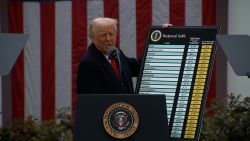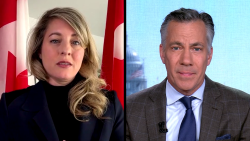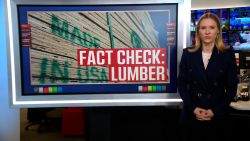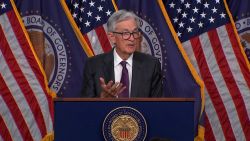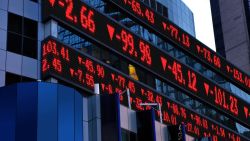President Donald Trump is stepping up his massive global trade war, a move that’s certain to weigh on Americans’ wallets and could push the US economy into a painful recession.
On Wednesday, Trump declared a national economic emergency and announced tariffs of at least 10% across all countries, with rates going even higher for 60 countries deemed the “worst offenders,” according to White House officials.
One of the highest tariff rates of 49% will be levied on all Cambodian imports, according to a poster Trump displayed at a Rose Garden event Wednesday. Among the other newly announced tariff rates are 46% for Vietnam, 34% for China and 20% for the European Union.
In most cases, Trump said the rates are “half” the tariff rate that the other countries and trading blocs charge the US when factoring in currency manipulation and other trade barriers. It’s unclear precisely how the administration arrived at those numbers.
The tariffs, Trump said, “are going to give us growth.” The president has repeatedly touted tariffs as a way to help the US government rely less on income taxes as a main form of revenue. He’s even gone as far to say that tariff revenue could replace income taxes entirely. But economists are largely in agreement that tariffs are paid by the country importing the goods, and have historically led to higher prices for consumers.
The escalation risks alienating the US further with foes and all the more so with key allies who have been long-time trading partners.
“It’s our declaration of economic independence,” Trump said Wednesday. “Jobs and factories will come roaring back into our country, and you see it happening already.”
The universal 10% rate will go into effect on April 5, while the customized rates will take effect on April 9, suggesting there could be more room for countries with rates higher than 10% to negotiate.
Countries with higher tariff rates are ones with what Trump referred to as “non-monetary barriers” and “monetary barriers” to trade in addition to tariffs they impose on American good.
“As bad as the higher tariffs are that the rest of the world punishes us with, the higher non-tariff barriers are far worse,” a senior White House official told reporters.
Among an extensive list of non-tariff trade Trump laid out were currency manipulation, tax policies viewed as unfair and the use of sweatshop labor.
“It’s all detailed in a very big report by the US Trade Representative on foreign trade barriers,” Trump said, holding up to the audience.
For the time being, the only exception to tariffs will be goods coming from Canada and Mexico that comply with the United States-Canada-Mexico Agreement signed under Trump’s first term.
Wednesday’s announcement is a far cry from the certainty on tariffs businesses have been craving since Trump’s November victory. Rather, it will open a whole new can of worms as countries respond to new tariffs with countermeasures on American goods, setting the stage for a new phase of negotiations that could escalate an already bitter trade war.
The tariffs that were already in place prior to Wednesday’s announcement — and the ongoing threat of heftier tariffs — have already dragged down the US economy at a precarious time, when a growing share of consumers are struggling financially.
His latest round of tariffs is the most substantial package in nearly 80 years. Consumers are still reeling from the highest inflation levels in 40 years and feeling crunched by high interest rates.
This story is developing and will be updated.

